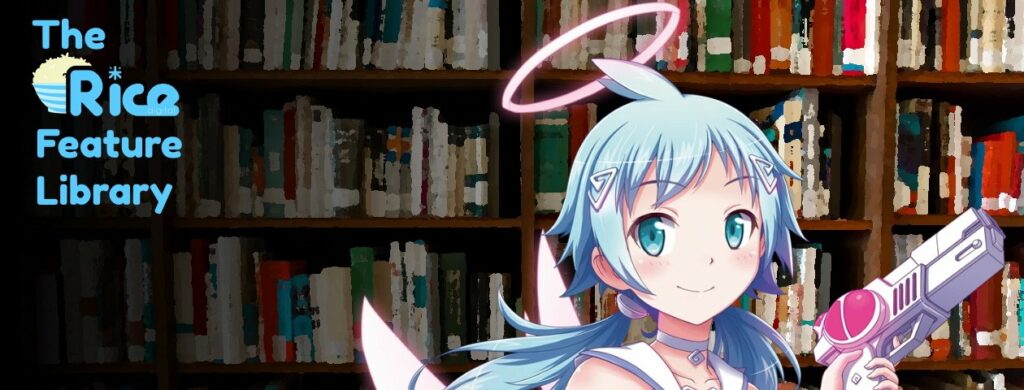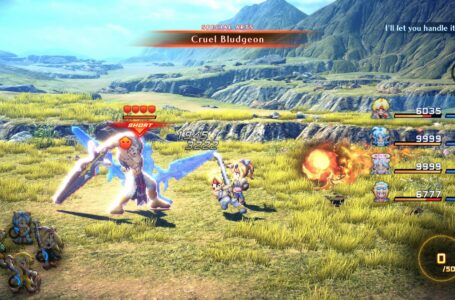Final Fantasy Pixel Remaster: is it worth it?
The Final Fantasy Pixel Remasters from Square Enix have attracted some mixed opinions ever since they were announced. While most people agreed that it would be great to see the first six installments in the series get a proper rerelease — and in a distinctly better-looking form than the abominable mobile ports from a while back — there were a number of questions.
Why were these new versions set to lack the additional content from the excellent Game Boy Advance and PSP versions? Why were they PC exclusives? Why did the sprites look a little bit odd? And why, dear Lord, why, did they think using a half-width font for the English text was a good idea? (Thankfully, that last one is easy to fix.)
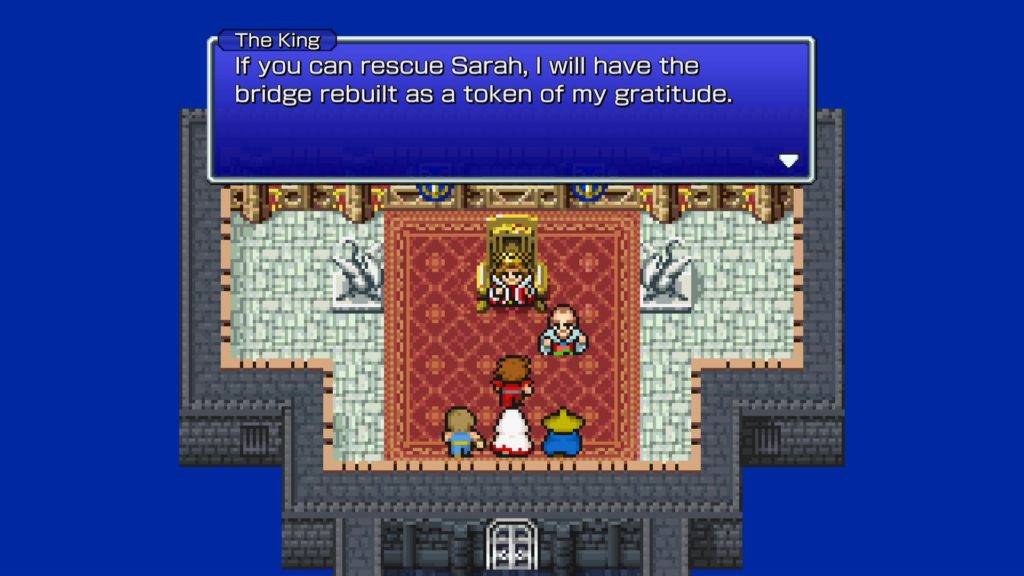
As a longstanding fan of Final Fantasy in general, I figured I’d bite the bullet and check things out properly. So I laid down my £55, bought the first three Final Fantasy Pixel Remasters (which are currently available), preordered the next three (which don’t have a release date as yet) and settled in to check things out.
Each Final Fantasy game is notably different from the last, so it pays to look at each one individually. So that’s exactly what we’re going to do — beginning with my first impressions of the first Final Fantasy Pixel Remaster after playing through the game’s initial sequence.
What is Final Fantasy?
This may sound like a stupid question given the series’ continuing popularity, but Final Fantasy as a series has changed a great deal over the years — so it’s entirely possible that people who came to the series more recently might not be familiar with the early installments.
In fact, back in 2016, Hiroki Chiba, director of monster-collecting spin-off title World of Final Fantasy, explained that the series longstanding director Hironobu Sakaguchi had always striven to work by the creed “if it’s not new, it’s not Final Fantasy”.
And, indeed, we’ve seen that a number of times over the years, with different people particularly appreciating certain installments and play styles more than others.
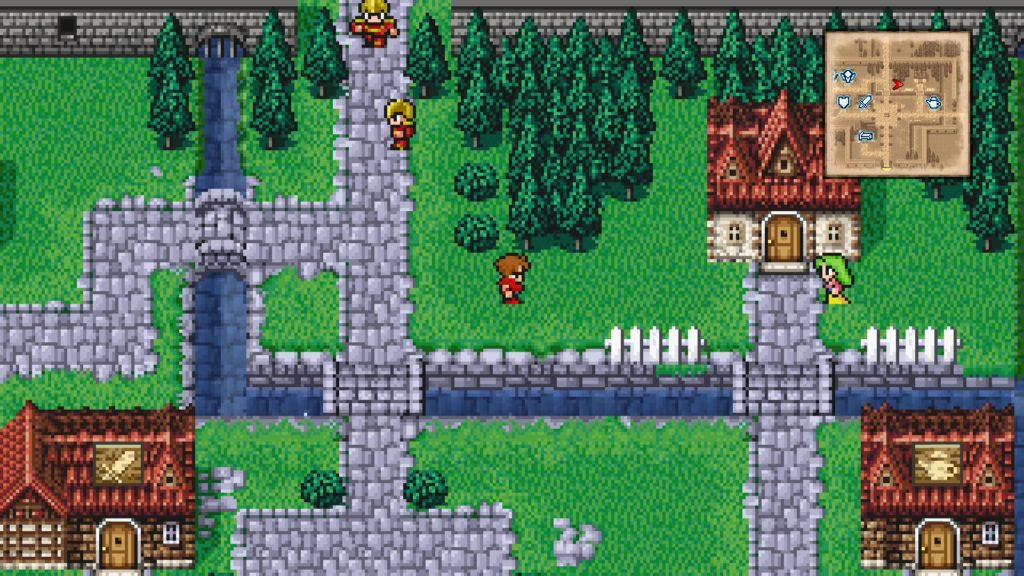
But the beautiful thing about the series as a whole is that it’s never stood still; even where individual canonical installments have multiple “parts” (such as the X and XIII mini-series) no two games are quite alike. And thus liking “modern Final Fantasy” isn’t necessarily a guarantee you’ll like “old Final Fantasy”… and vice-versa, of course.
Back in 1987, when Final Fantasy was first released for the Famicom in Japan, the idea of a “role-playing game” was still relatively new — particularly out east. As such, the first Final Fantasy very much looks to western works for inspiration.
Mechanically and structurally, Final Fantasy resembles classic western RPGs such as Wizardry and Ultima more than the story-centric experiences we typically associate with Japanese role-playing games today. That means there’s a rather “free-form” feel to the game, with your party tending to stumble across new things to do rather than being railroaded along a linear plot — though there is an optimal order in which to do things.
The game’s bestiary is basically ripped straight from the Dungeons & Dragons Monster Manual — something which the series continues to do somewhat more subtly today. Final Fantasy XIV even has a tarrasque in it — though in somewhat less threatening form than D&D’s incarnation.
And rather than using the Magic Points system we typically associate with Japanese RPGs today, Final Fantasy makes use of a quasi-Vancian magic system in which you have to learn and prepare spells in advance, with casters limited to a set number of spells from each “tier” per in-game “day” — with a “day” here defined as the amount of time you play without allowing your characters to take a rest in an inn or tent.
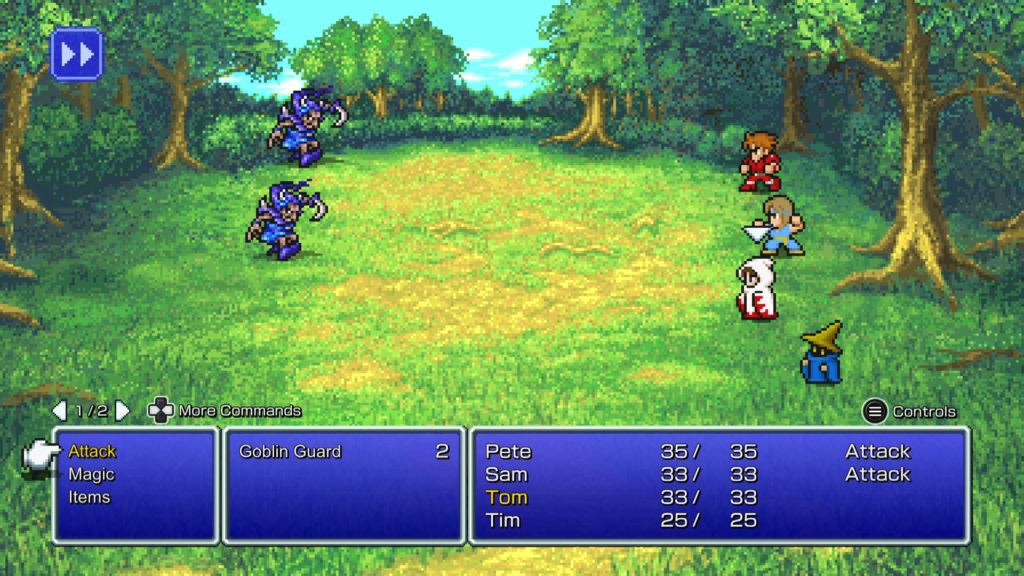
The bad news
Let’s get the bad news about the Final Fantasy Pixel Remaster out of the way first. Because despite how easy it is to be cynical about these rereleases, there’s actually only a few things I’d really level at them as criticisms; how much of a “dealbreaker” they are will likely depend on the individual.
The first thing is, obviously, the font. As we’ve established, this is easy to fix — but it shouldn’t be necessary to do this. Someone at Square Enix should have looked at that horrid half-width font at some point during testing and said “maybe this isn’t the best idea”. But they didn’t. Which means if these games ever get a console release, we’ll likely be stuck with said font on those platforms — unless, of course, Square Enix pay attention to this common criticism and fix it.
The second thing is that the performance is surprisingly variable. On my system, the game was riddled with screen tearing and jerky scrolling, necessitating the manual activation of VSync and Triple Buffering in my graphics card’s control panel. There are no meaningful graphical options in the game itself, which is not really acceptable for a PC game in 2021, given how much everyone’s hardware configurations vary.
Even with VSync and Triple Buffering activated, the scrolling still isn’t as smooth as it could be; I feel like in 2021 we should have 2D pixel art scrolling pretty much nailed — particularly in a remaster of a 34 year old game — but apparently not.
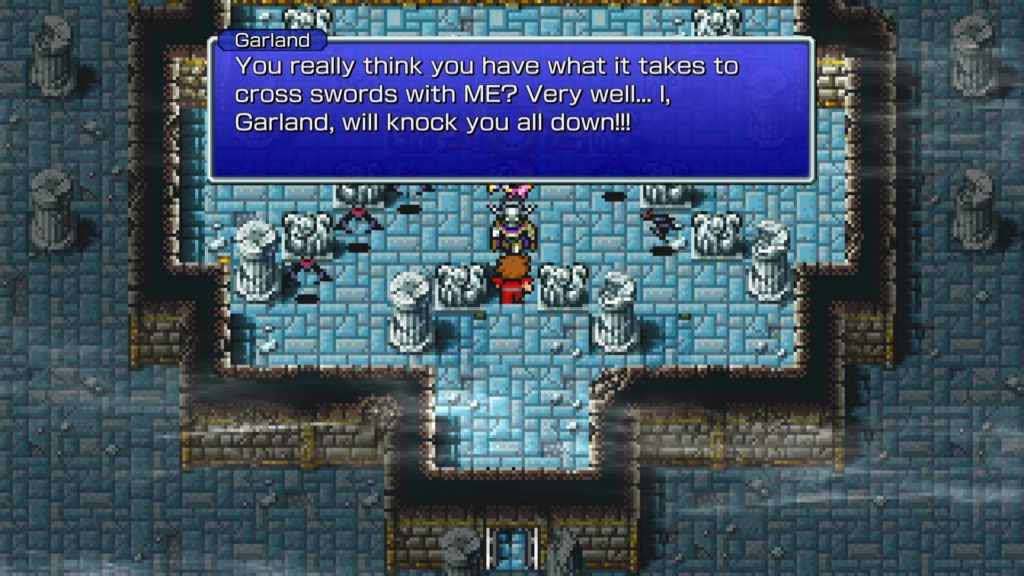
Thirdly, there are a couple of tiny little niggles about how the game implements its mechanics — most notably the fact that when your lead character in the party dies, they are still able to walk around on the world map and field screen. In previous versions of the game, the field sprite was replaced by the next living member of the party, but not in this one.
Fourthly — and this one really is a matter of personal taste — Final Fantasy Pixel Remaster’s balance is based on the “Easy” mode introduced in the PlayStation 1’s Final Fantasy Origins, rather than the grind-heavy Famicom original. I personally prefer this, because it means the game never feels like it’s getting bogged down, but some purists are upset at not even having the option to adjust the difficulty.
Finally, as previously noted, this version of Final Fantasy lacks the additional dungeons introduced in the Game Boy Advance “Dawn of Souls” and PSP “Anniversary” releases of Final Fantasy. These included four challenging endgame dungeons themed around the four elemental crystals, each containing bosses that paid homage to later installments in the series; and a puzzle-centric labyrinth with a challenging optional boss.
Between them, these dungeons provided the game with some meaningful endgame content, so it’s a shame to see the back of them.
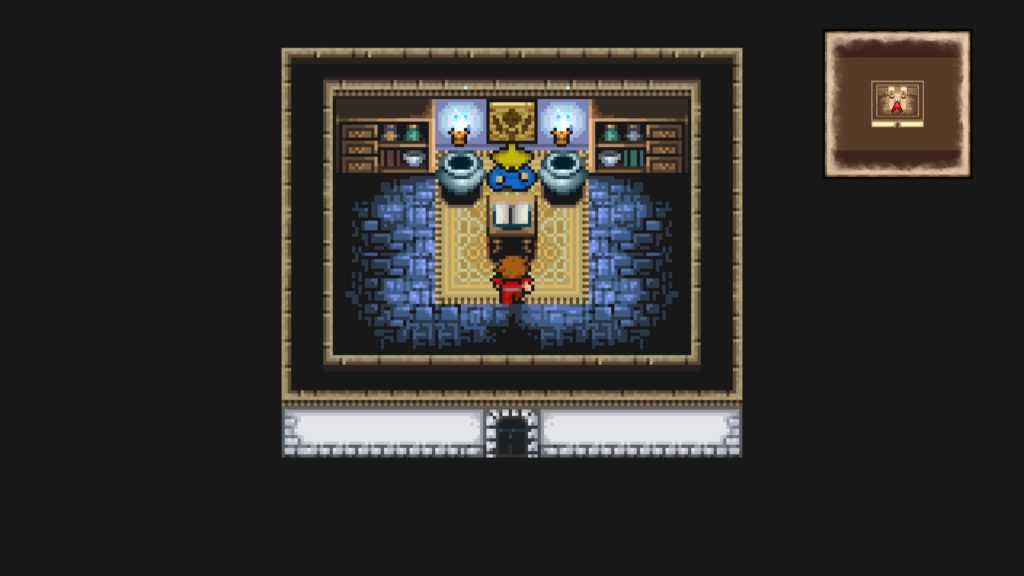
The good news
Okay, with all that out of the way I’m willing to admit that I’m actually rather impressed with the Final Fantasy Pixel Remaster edition. Navigating around the game is slick and elegant, with smooth transitions between areas, menu screens, shops and other interface elements.
Simple additions to the game interface, such as being able to see how close you are to levelling up and seeing your actual stat increases upon levelling up, make the mechanics of the game simpler to parse without sacrificing any of the original game’s distinctive feel.
You can move diagonally for the first time in a 2D Final Fantasy game, which initially feels really weird, but subsequently makes getting around a lot easier — as does the addition of a very welcome minimap.
The graphics look really nice, scrolling aside. The new pixel art water effect is particularly pleasing to look at. My only real issue is that some of the enemy sprites that should really look a bit more threatening — Garland and the Vampire are good examples — look a bit too small on screen.
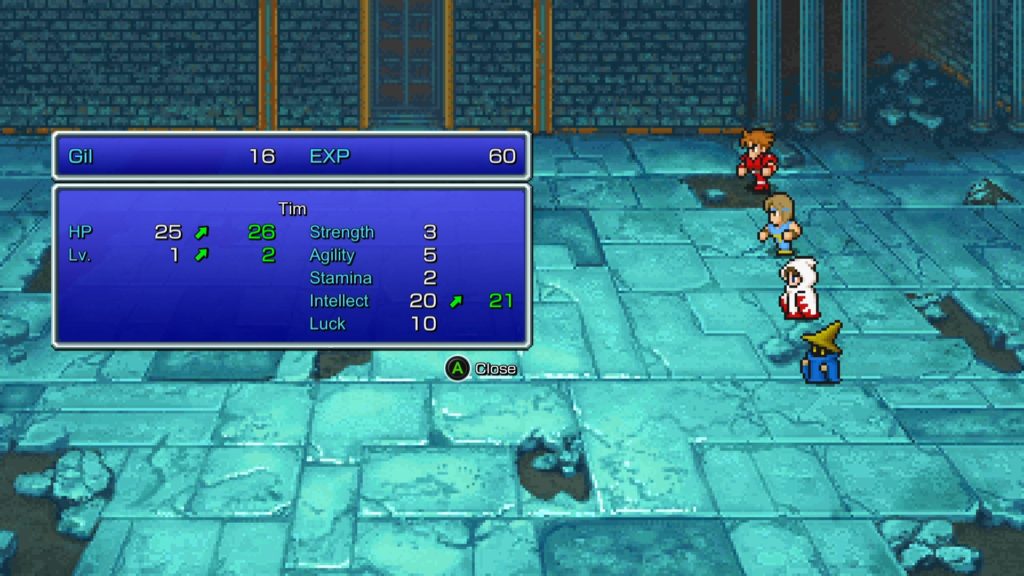
In isolation, the flatter shading of the character sprites when compared to the PSP and Game Boy Advance versions of Final Fantasy might look a bit dodgy — but in context, they work well; the vibrant colours of the sprites make them stand out nicely against the tile-based backgrounds, and they capture the feel of the original Famicom sprites nicely.
And the music. Dear God, the music. The music alone makes Final Fantasy Pixel Remaster worth picking up, because it really is astonishingly good. Making use of authentic orchestral instruments, the remastered tracks would be good enough if they simply recreated the classic tracks — but no, these are proper rearrangements, with extended, developed sections over and above the original musical loops.
All of them are absolutely magnificent — which makes it utterly baffling that the “OST” Square Enix provides with the bundle on Steam contains just three tracks in “timelapse remix” form, where they gradually change from the original Famicom chiptune to the new orchestral version over the course of a couple of minutes. Granted, they’re three of the best tracks, being the main world map theme, the theme for Matoya’s Cave and the battle theme, but it still feels a bit stingy.
Is it worth it?
I used to think of the first Final Fantasy as one of my least favourite installments in the series, but somehow over the years I’ve ended up playing it through more times than pretty much any other entry — and I’ve come to love it over the years, particularly in the Game Boy Advance and PSP incarnations I’ve mentioned several times previously.
I was initially skeptical that Final Fantasy Pixel Remaster would capture and maintain my attention due to its notable shortcomings — but honestly, the combination of the incredible music and the way in which the mechanical edges have been nicely smoothed out are enough to make me overlook those issues.
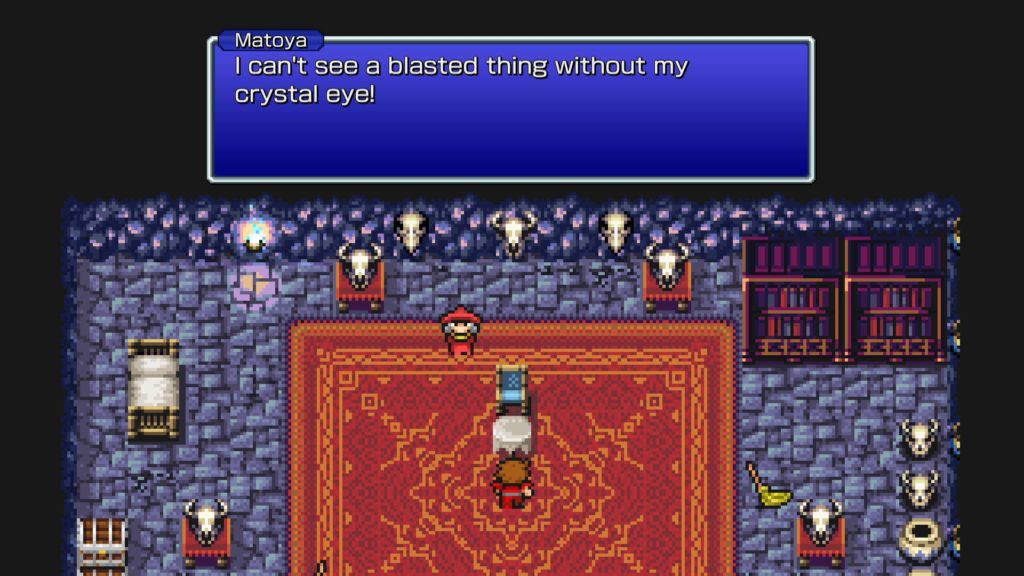
While I will miss delving into the Labyrinth of Time and kicking the snot out of multiple incarnations of Chronodia in this version, I do still have a copy of the PSP version where I can do that any time I want. So while it’s a shame that newcomers to the first Final Fantasy won’t have the opportunity to take part in those enjoyable endgame jaunts, the main game is completely intact — and, with a couple of tweaks, very enjoyable to engage with. Plus, for under a tenner when bought solus, it’s a good deal.
Here’s hoping that if Square Enix decides to do console ports of Final Fantasy Pixel Remaster and its follow-ups — and I sincerely hope they do, particularly if they do physical release — that they pay attention to the most common bits of feedback they’ve been receiving, and truly make those versions the definitive ways to play.
Final Fantasy Pixel Remaster is available now on Steam.
Join The Discussion
Rice Digital Discord
Rice Digital Twitter
Rice Digital Facebook
Or write us a letter for the Rice Digital Friday Letters Page by clicking here!
Disclosure: Some links in this article may be affiliate links, which means we may earn a small commission if you make a purchase after clicking on them. This is at no additional cost to you and helps support Rice Digital!
- Letter from the Editor: passing the torch - June 30, 2023
- Super Woden GP 2 is looking promising - June 30, 2023
- Inti Creates is making a 32 bit-style Love Live action platformer - June 26, 2023



